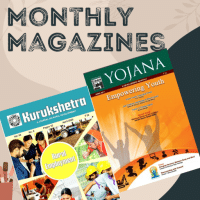Current Affairs Exam > Current Affairs Questions > Regarding the Quantum Random Number Generator...
Start Learning for Free
Regarding the Quantum Random Number Generator (QRNG), consider the following statements:
1. It has the ability to detect random quantum events and convert those into a stream of binary digits.
2. CSIR developed it.
1. It has the ability to detect random quantum events and convert those into a stream of binary digits.
2. CSIR developed it.
Which of the statements given above is/are correct?
- a)1 only
- b)2 only
- c)Both 1 and 2
- d)Neither 1 nor 2
Correct answer is option 'A'. Can you explain this answer?
Verified Answer
Regarding the Quantum Random Number Generator (QRNG), consider the fol...
The DRDO Young Scientist Laboratory for Quantum Technologies (DYSL-QT), a DRDO facility based in Mumbai, has developed a Quantum Random Number Generator (QRNG) which has the ability to detect random quantum events and convert those into a stream of binary digits.
- The Laboratory has developed a fibre-optic branch path based QRNG.
- The branch path-based QRNG is based on the principle that if a single photon is an incident on a balanced beam splitter, it will randomly take either of the beam-splitter output paths.
- As the path chosen by the photon is random, the randomness is translated to a sequence of bits.
Significance:
- With this development, India enters the club of countries with the technology to achieve random numbers based on the Quantum Phenomena.
- Random numbers have essential roles in various fields ranging from quantum communication, cryptography applications like key generation, key wrapping, authentication, scientific simulations, lotteries and fundamental physics experiments.
- The generation of perfect randomness is generally considered impossible with classical methodologies.
- Quantum mechanics has the inherent potential of providing true random numbers and has become the preferred option for scientific applications requiring randomness.
- DYSL-QT is one of the five YSLs (Young Scientist Laboratories) of the DRDO working on five different technologies.
- The other facilities are Artificial Intelligence (DYSL-AI) Bengaluru, Cognitive Technologies (DYSL-CT) Chennai, Asymmetric Technologies (DYSL-AT) Kolkata, Smart Materials (DYSL-SM) Hyderabad.
- These five facilities were dedicated to the nation by Prime Minister Narendra Modi in January this year.
Most Upvoted Answer
Regarding the Quantum Random Number Generator (QRNG), consider the fol...
Answer:
Introduction:
The Quantum Random Number Generator (QRNG) is a device that generates random numbers based on the principles of quantum mechanics. It is designed to provide truly random numbers that cannot be predicted or replicated. In this question, we need to determine the correct statements about the QRNG.
Statement 1: It has the ability to detect random quantum events and convert those into a stream of binary digits.
Statement 2: CSIR developed it.
Explanation:
Statement 1: It has the ability to detect random quantum events and convert those into a stream of binary digits.
The first statement is correct. A Quantum Random Number Generator (QRNG) uses the principles of quantum mechanics to generate random numbers. Quantum mechanics states that certain events at the quantum level, such as the decay of a radioactive atom or the detection of a photon, are inherently random. QRNGs exploit these random quantum events to generate random numbers. The device detects these quantum events and converts them into a stream of binary digits, typically 0s and 1s, which can be used as random numbers.
Statement 2: CSIR developed it.
The second statement is incorrect. The Council of Scientific and Industrial Research (CSIR) is a premier research and development organization in India, but it is not specifically known for developing the Quantum Random Number Generator (QRNG). QRNGs have been developed by various research institutions and companies around the world, including universities and private companies specializing in quantum technologies.
Conclusion:
In conclusion, statement 1 is correct as the Quantum Random Number Generator (QRNG) has the ability to detect random quantum events and convert them into a stream of binary digits. However, statement 2 is incorrect as CSIR is not specifically known for developing the QRNG. Therefore, the correct answer is option 'A' (1 only).
Introduction:
The Quantum Random Number Generator (QRNG) is a device that generates random numbers based on the principles of quantum mechanics. It is designed to provide truly random numbers that cannot be predicted or replicated. In this question, we need to determine the correct statements about the QRNG.
Statement 1: It has the ability to detect random quantum events and convert those into a stream of binary digits.
Statement 2: CSIR developed it.
Explanation:
Statement 1: It has the ability to detect random quantum events and convert those into a stream of binary digits.
The first statement is correct. A Quantum Random Number Generator (QRNG) uses the principles of quantum mechanics to generate random numbers. Quantum mechanics states that certain events at the quantum level, such as the decay of a radioactive atom or the detection of a photon, are inherently random. QRNGs exploit these random quantum events to generate random numbers. The device detects these quantum events and converts them into a stream of binary digits, typically 0s and 1s, which can be used as random numbers.
Statement 2: CSIR developed it.
The second statement is incorrect. The Council of Scientific and Industrial Research (CSIR) is a premier research and development organization in India, but it is not specifically known for developing the Quantum Random Number Generator (QRNG). QRNGs have been developed by various research institutions and companies around the world, including universities and private companies specializing in quantum technologies.
Conclusion:
In conclusion, statement 1 is correct as the Quantum Random Number Generator (QRNG) has the ability to detect random quantum events and convert them into a stream of binary digits. However, statement 2 is incorrect as CSIR is not specifically known for developing the QRNG. Therefore, the correct answer is option 'A' (1 only).

|
Explore Courses for Current Affairs exam
|

|
Similar Current Affairs Doubts
Regarding the Quantum Random Number Generator (QRNG), consider the following statements:1. It has the ability to detect random quantum events and convert those into a stream of binary digits.2. CSIR developed it.Which of the statements given above is/are correct?a)1 onlyb)2 onlyc)Both 1 and 2d)Neither 1 nor 2Correct answer is option 'A'. Can you explain this answer?
Question Description
Regarding the Quantum Random Number Generator (QRNG), consider the following statements:1. It has the ability to detect random quantum events and convert those into a stream of binary digits.2. CSIR developed it.Which of the statements given above is/are correct?a)1 onlyb)2 onlyc)Both 1 and 2d)Neither 1 nor 2Correct answer is option 'A'. Can you explain this answer? for Current Affairs 2025 is part of Current Affairs preparation. The Question and answers have been prepared according to the Current Affairs exam syllabus. Information about Regarding the Quantum Random Number Generator (QRNG), consider the following statements:1. It has the ability to detect random quantum events and convert those into a stream of binary digits.2. CSIR developed it.Which of the statements given above is/are correct?a)1 onlyb)2 onlyc)Both 1 and 2d)Neither 1 nor 2Correct answer is option 'A'. Can you explain this answer? covers all topics & solutions for Current Affairs 2025 Exam. Find important definitions, questions, meanings, examples, exercises and tests below for Regarding the Quantum Random Number Generator (QRNG), consider the following statements:1. It has the ability to detect random quantum events and convert those into a stream of binary digits.2. CSIR developed it.Which of the statements given above is/are correct?a)1 onlyb)2 onlyc)Both 1 and 2d)Neither 1 nor 2Correct answer is option 'A'. Can you explain this answer?.
Regarding the Quantum Random Number Generator (QRNG), consider the following statements:1. It has the ability to detect random quantum events and convert those into a stream of binary digits.2. CSIR developed it.Which of the statements given above is/are correct?a)1 onlyb)2 onlyc)Both 1 and 2d)Neither 1 nor 2Correct answer is option 'A'. Can you explain this answer? for Current Affairs 2025 is part of Current Affairs preparation. The Question and answers have been prepared according to the Current Affairs exam syllabus. Information about Regarding the Quantum Random Number Generator (QRNG), consider the following statements:1. It has the ability to detect random quantum events and convert those into a stream of binary digits.2. CSIR developed it.Which of the statements given above is/are correct?a)1 onlyb)2 onlyc)Both 1 and 2d)Neither 1 nor 2Correct answer is option 'A'. Can you explain this answer? covers all topics & solutions for Current Affairs 2025 Exam. Find important definitions, questions, meanings, examples, exercises and tests below for Regarding the Quantum Random Number Generator (QRNG), consider the following statements:1. It has the ability to detect random quantum events and convert those into a stream of binary digits.2. CSIR developed it.Which of the statements given above is/are correct?a)1 onlyb)2 onlyc)Both 1 and 2d)Neither 1 nor 2Correct answer is option 'A'. Can you explain this answer?.
Solutions for Regarding the Quantum Random Number Generator (QRNG), consider the following statements:1. It has the ability to detect random quantum events and convert those into a stream of binary digits.2. CSIR developed it.Which of the statements given above is/are correct?a)1 onlyb)2 onlyc)Both 1 and 2d)Neither 1 nor 2Correct answer is option 'A'. Can you explain this answer? in English & in Hindi are available as part of our courses for Current Affairs.
Download more important topics, notes, lectures and mock test series for Current Affairs Exam by signing up for free.
Here you can find the meaning of Regarding the Quantum Random Number Generator (QRNG), consider the following statements:1. It has the ability to detect random quantum events and convert those into a stream of binary digits.2. CSIR developed it.Which of the statements given above is/are correct?a)1 onlyb)2 onlyc)Both 1 and 2d)Neither 1 nor 2Correct answer is option 'A'. Can you explain this answer? defined & explained in the simplest way possible. Besides giving the explanation of
Regarding the Quantum Random Number Generator (QRNG), consider the following statements:1. It has the ability to detect random quantum events and convert those into a stream of binary digits.2. CSIR developed it.Which of the statements given above is/are correct?a)1 onlyb)2 onlyc)Both 1 and 2d)Neither 1 nor 2Correct answer is option 'A'. Can you explain this answer?, a detailed solution for Regarding the Quantum Random Number Generator (QRNG), consider the following statements:1. It has the ability to detect random quantum events and convert those into a stream of binary digits.2. CSIR developed it.Which of the statements given above is/are correct?a)1 onlyb)2 onlyc)Both 1 and 2d)Neither 1 nor 2Correct answer is option 'A'. Can you explain this answer? has been provided alongside types of Regarding the Quantum Random Number Generator (QRNG), consider the following statements:1. It has the ability to detect random quantum events and convert those into a stream of binary digits.2. CSIR developed it.Which of the statements given above is/are correct?a)1 onlyb)2 onlyc)Both 1 and 2d)Neither 1 nor 2Correct answer is option 'A'. Can you explain this answer? theory, EduRev gives you an
ample number of questions to practice Regarding the Quantum Random Number Generator (QRNG), consider the following statements:1. It has the ability to detect random quantum events and convert those into a stream of binary digits.2. CSIR developed it.Which of the statements given above is/are correct?a)1 onlyb)2 onlyc)Both 1 and 2d)Neither 1 nor 2Correct answer is option 'A'. Can you explain this answer? tests, examples and also practice Current Affairs tests.

|
Explore Courses for Current Affairs exam
|

|
Signup for Free!
Signup to see your scores go up within 7 days! Learn & Practice with 1000+ FREE Notes, Videos & Tests.


























